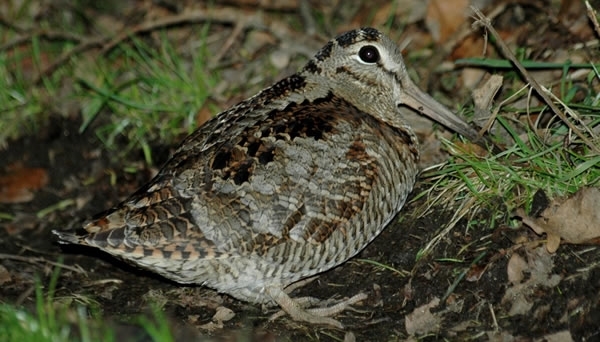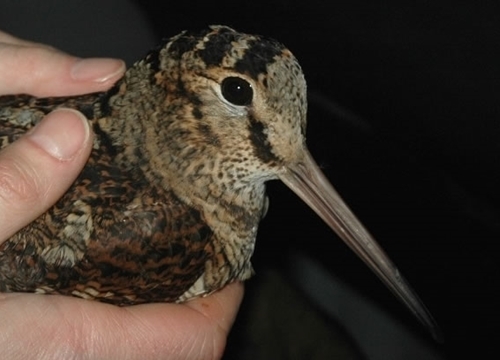
Dr Andrew Hoodless, GWCT Head of Wetlands Research, discusses new research on the effect of cold weather on the Eurasian woodcock and the recent article 'Regulation of body reserves in a hunted wader: Implications for cold-weather shooting restrictions'.
Severe winter weather can place a strain on the energy reserves of birds, sometimes resulting in mortality if adverse conditions persist for more than a few days. There are relatively few studies of the effects of severe weather events on the regulation of energy reserves and even fewer on the additive effects of human activities, including hunting, during such weather on winter survival.
As in many other birds, the Eurasian woodcock faces a daily trade-off in winter: carry too little fat and it risks starving, carry too much fat and it reduces its ability to escape from predators. It is unusual among waders in the sense that it rarely visits the coast, but resides inland year-round, feeding on soil invertebrates, largely in fields at night but also in woodland by day.
It is forced off its breeding grounds in Scandinavia, Finland, the Baltic States and Russia by the onset of cold weather in autumn and migrates to milder wintering areas in southern and western Europe. The woodcock is widely hunted throughout its European wintering areas, with around 2.3-3.5 million birds shot per year, mainly in France, Italy, Britain, Ireland and Spain.
To reduce the disturbance impact of shooting gamebirds under stress during cold spells, some European countries impose restrictions during these periods. However, these measures are largely based on ‘best guesses’ using data collected for a small number of species over 30 years ago.
Shooting restrictions are designed to protect a range of species, but do not necessarily take adequate account of the potential impacts on individual species. Corpses of starved woodcock have been reported in prolonged spells of unusually cold weather, but details of when woodcock start to be impacted and how long they are able to survive under different conditions are lacking.
Following discussion with hunters who sought guidance on best practice during cold weather, we thought it would be timely to assess the suitability of current measures for protecting woodcock and to draw up some advice for shooters.
Our study
The aim of our study was to examine variation in energy reserves, and hence the potential fasting endurance or escape flight distance, of woodcock. Food, in the form of earthworms, is very abundant and widespread in most western European landscapes and hence, in mild conditions, it is unlikely to ever be limiting.
Consequently, we hypothesized that woodcock should be able to regulate their energy reserves efficiently until weather conditions result in soil invertebrates remaining too deep to be accessible or in woodcock being unable to probe the soil.
We dissected a sample of 221 birds from shoots in Britain in winter to examine individual variation in fat stores and the relationship between fat levels and body weight. We then used biometric data from birds captured at our regular ringing sites (1689 captures during 2010/11-2015/16) to assess changes in mobilizable energy in relation to season and weather and, in particular, to assess changes during cold spells.

A ringed woodcock about to be released. Biometrics collected during an intensive ringing programme, by Andrew Hoodless of the Game & Wildlife Conservation Trust and Owen Williams from the Woodcock Network, enabled the relationships between winter weather and energy reserves to be determined. (Photo: Chris Heward)
Our findings
We found that woodcock are able to store large amounts of energy as fat, with weights ranging from 240 g in birds carrying little fat to 390 g in birds with maximum fat loads. Energy reserves in mid-winter were negatively related to night air temperature, even when below 0°C, all the time that the ground thawed during the day.
This suggests that, as indicated by previous research, woodcock are able to compensate for difficult feeding conditions at night by increasing the time spent feeding during the day. Once permanently frozen conditions set in, however, our data suggest that there is the potential for woodcock to starve to death within a week.
In the event of a cold spell in Britain, woodcock could, on average, make escape flights of 860 km or withstand frozen conditions without feeding for six days. During cold spells (defined as days with minimum daily air temperature below 0°C), mobilizable energy was reduced by the combination of cold spell duration and minimum temperature and we found an indication that adult woodcock were better able to maintain their energy reserves between -2°C and -8°C than first-winter birds.
In Britain, voluntary restraint in the shooting of wildfowl and waders is recommended after seven consecutive days of frozen conditions are recorded at more than half of a network of 25 coastal meteorological stations, although statutory suspension does not come into force until day 15.
A ‘Protection Order’ of 14 days is then enforced, although it can be revised after seven days. Since the mean fasting endurance of woodcock is six days, there is the potential for substantial mortality before the triggering of ‘voluntary restraint’ or the statutory suspension of hunting if weather conditions result in continuous frozen ground. In reality, many birds are likely to fly south and west, where possible, to escape the freezing conditions and may be able to find unfrozen ground to feed.
However, they will then have expended some of their energy reserves and may be at greater predation risk in an unfamiliar landscape. They should therefore also be protected from hunting in regions experiencing less severe conditions, that afford refuge, for as long as restrictions are imposed in areas with frozen conditions.
There is currently no alert within the British cold-weather shooting policy for conditions leading to frozen ground inland. Indeed, there is no common approach between countries within the wintering range of the woodcock to cold weather shooting restrictions. Although the incidence of cold spells likely to prevent woodcock from feeding is low (3-6 occasions lasting 5-10 days, dependent on region, in the last ten years), improved alerts could afford woodcock better protection when such conditions materialise.
Such alerts are likely to be needed more frequently in Britain than in other countries, because the difference between day and night temperatures when the ground is frozen at night, is small in Britain compared to Spain or Italy, for instance, where there is more chance of a thaw during the day.
Our advice for shooters
We suggest that shooters across Europe should adopt a more cautious approach to shooting woodcock in cold weather and should stop after four days of frozen conditions and allow the birds at least seven days to recover after the end of the cold period before shooting recommences.
We think statutory authorities across Europe should adopt a consistent approach and consider a regional system for an alert advising cessation of woodcock shooting after four days of frozen conditions across an appropriate range of inland sites. Shooting organizations and hunters’ clubs could play an active role, especially through social media, in quickly raising awareness of adverse conditions and promoting good practice.
Read the full article, Regulation of body reserves in a hunted wader: Implications for cold-weather shooting restrictions, in Journal of Applied Ecology.
Support our vital woodcock research